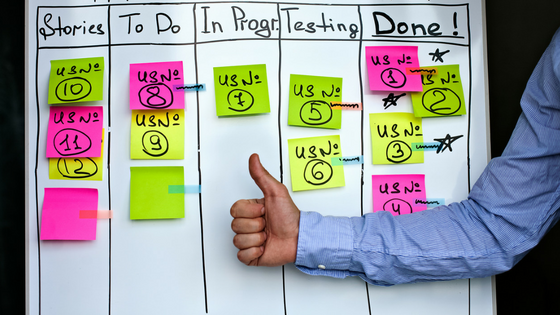What do Starbucks, Toyota, Nestle, and Gujarat Government all have in common?
Besides having a significant impact on the lives of many, every single one of these influencers bases their core practices around a simple yet effective philosophy that also doubles as a way of life. We’re talking, of course, about the Kaizen Method.
Kaizen (which means “good change” in Japanese) is a way of life that emphasizes the day-to-day completion of tasks and incremental milestones that add up to a larger goal.
These days, Kaizen is being used as an umbrella term used to describe a whole set of ideas, buzzwords, and concepts that are designed to optimize a company’s culture and efficiency. And for good reason: it’s an effective approach to all levels of life. Kaizen is about the steady improvement of each of them. It teaches you patience, humility, discipline, and the wonders of true workplace collaboration. Also, most importantly, the mechanics of progress and the importance of organization - both in your workplace environment and your mental space.
In fact, if you don’t implement the basic principles of Kaizen in your personal life, you’re doing it wrong - traditionally speaking. One of Kaizen’s foundations is the practice of Hansei, meaning “self-reflection,” which is a concept that’s rooted in the center of Japanese culture. Hansei is all about the refining the art of self-critique. It prioritizes acknowledging your own personal shortcomings - emotional or otherwise - and figuring out how to overcome them during the next phase.
Therefore, Kaizen is focused on the improvement of the individual just as much as that of the collective, since they are both one and the same. We’ve come up with five tips to help you adopt the Kaizen way into your life to build a better you and a better “us.”
Build habits, not castles in the sky
Meaningful change is not glamorous, nor is it easy. You can't jump into a phone booth and then fly back out as ideal you that you’re seeking to be, no matter how convenient that would be. In fact, the actual process of change - evolution, if you will - is tedious, redundant, and boring. Most analogies that are used to illustrate the concepts of Kaizen revolve around working out at the gym - and for good reason. That’s precisely the kind of mindset you need to be in to embrace Kaizen.
ALSO READ: 5 Business Processes You Can Run Better Without Excel Spreadsheets
Picture a bodybuilder at the gym. They show up 3-5 days a week with a plan of action in mind, whether it be a routine that they developed themselves or they learned from a trainer, and they stick to it. Each day, for 1-2 hours, they focus developing one muscle group in their body. With each piece of equipment, they perform several sets of 8-12 repetitions to do so. When this itemized list of activities is checked off, they leave and go home to eat enough protein to feed the muscles that were exercised.
If you’re like most people, you skimmed through that last paragraph. Why? Because it’s not interesting whatsoever. It describes in detail the process of slow, continuous improvement as it relates to working out. The paragraph right above that, though, was more interesting to read because it has that sentence which references a quick, superhero-esque transformation. It gets us where we want to be quicker, which is exactly things work on the mental plane. If you want to see a significant change in the physical world, you must learn to focus on specific, actionable processes that you pick up as a habit.
But why is it so difficult to imagine what the momentary steps to building our better future are than it is to dream about what that will look like? Because, if we’re being honest, there’s no way around fantasizing. We need to do this to motivate ourselves in order to actually want to think about building the processes. Allow yourself some time here and there to live in the daydream about your goal being achieved - like, say, when you are in transit - but start being more conscious of how you can outline “behavior chains” that will help you visualize the habits you need to create in order to manifest it.
Let’s revisit the classic gym analogy for an example to illustrate this. Instead of focusing on a thought like: “I’m going to be ripped and feel better about myself...one day!” You could instead think of it like this: “When I get off of work today, I can run home and grab my workout clothes. Then, I will google that workout routine my friend posted a couple weeks ago that I wanted to try out. After that, I will head to the gym where I will do warm-ups. Then, I will focus on doing a set of bench presses...” and so on, and so forth. It’s not nearly as fun or as gratifying as picturing yourself as a pro-bodybuilder, but it will do something better than make you feel good temporarily - it will make you feel great in the long haul.
Take your time - and learn to spend it wisely
Seriously: what’s the rush? If you focus on the destination and not the journey, the trip will feel unbearable. If you focus on each of the steps you take, you’ll discover a whole new world of possibility you’re overlooking because you actually being present. Taking time to plan our your goals, to outline your targets as thoroughly as possible, and to be as specific as possible about what the processes to reach these will look like moment-to-moment will eliminate vast amounts of waste in the long-run.
Impatience is bred every minute of every day in our current online culture, and our expectations about how much time major changes will take have become increasingly unrealistic (and sometimes unempathetic) as a result. Demanding immediate results from yourself or those you manage isn’t the answer. That way of thinking will only create obstacles and weigh things down. It will also make the whole venture seem that much more impossible.
Instead, choose to learn how to make the best of the moments that you have. If you spend most of your actual work time making too many spreadsheets or filling out forms that aren’t as urgent or nearly as important as carrying out the tasks that will actually carry faster you to your ultimate goal, ask yourself the big Kaizen question: why? Why would you be an obstacle to yourself? Alternatively, if you choose to eat up time by holding too many meetings where big ideas are brought up that never quite materialize, take control of yours. Choose not to create obstacles or waste in your life and the lives of those you are leading. Limit your meetings to one huddle a day, at the start, and get everyone’s input about what went right and what needed improvement during the prior day’s session.
But the moral of this part of the story is: plan, plan, plan - and then plan some more. That way, you’re prepared for your journey to a bright and shining future.
“Baby steps” are better
Remember how we talked about how more satisfying it is for us to live in the fantasy of our goals rather than it is to picture actionable plans to make them happen? This harms us in other ways than just distracting us from figuring out moment-to-moment action steps. It forces us into a state of inaction that has more to do with being overwhelmed by the sheer magnitude of the work we have cut out for us than anything else.
If you’re like most people, your past attempts at improvement have tapered off or were dropped completely because you either demanded too much of yourself too early on (like trying to fit in three hours at the gym on your first day) because of you crave immediate results or you feel as though you must do everything at once. This form of mental self-abuse is what Kaizen was designed to circumvent.
Instead of setting yourself up for failure by pretending you can live up to unrealistic standards that will only stress you out and make you rebel against your plans, take small steps. Do only what you feel comfortable with for as long as you can stand to do it, once a day, every day. If you can only bring yourself to work on your goal for a minute, do that, without beating yourself up. Rather, pride yourself in the fact that you are moving towards what you really want. Before you know it, you’ll be spending more and more time working on your goal as your enthusiasm and self-confidence steadily grows.
RELATED: 4 Ways Traditional Software Fail Business Managers and Delay Digital Transformation
Accept your faults and befriend them
We all have faults. There’s no getting around them. But here’s the thing: you’re the one who gets to decide if they have control over you or not. If you are a master procrastinator, then identify that as an obstacle on your path that you will work around. Don’t focus on holding shame or guilt about it. These emotions will only feed your inaction. If you approach projects or tasks with a sense of trepidation or dread because you know deep down they will force you to confront faults or character flaws that you’d rather pretend aren’t there, stop. Be gentle yet disciplined with yourself. How can you work around them, or have them work better for you?
Remember: you can’t get rid of what you don’t like about yourself overnight. You can only accept these things, identify them as what they are, and assimilated them into your personality. Disowning parts of yourself will only cause dissonance within your psyche which will create waste and promote stagnation.
When brainstorming, be as visual as possible
Don’t be afraid to map out your dreams, especially when you’re working towards realizing them with others. Mind mapping (or concept mapping) may seem like a superficial activity to some, but it when it comes to leading a team towards a shared goal, there’s nothing more useful when it comes to getting everyone on the same page. How come? The simple act of physically manifesting what’s floating around behind the curtain in the realm of ideas on a whiteboard, screen, or piece of paper opens up the doorways to possibility and gets generates a creative electricity that will charge up your motivational batteries.
There is no right or wrong way to map out your ideas, but author Tony Buzan came up with several guidelines that are still the guidelines of this process to this day. You can check them out here .
Accept that the journey never ends
When your work is finished, the project is complete, and the goal has been achieved: what then? Do you stop completely, or do you keep changing and moving down the road? Will you stop at the peak of the mountain that you’ve reached, content with what you’ve done, or will you decide to go on a greater adventure and climb the bigger mountain that beckons you on the horizon?
If the key to Kaizen is “continuous self-improvement,” that means there really is no final destination on your path to you or your team’s ultimate development. You determine whether or not there is an endpoint. Will you halt your own progress and be content with what you’ve accomplished, or will you continue to discover the true gifts that you can share with others?
Only you can answer these questions. (And, quite possibly, your stakeholders.)











